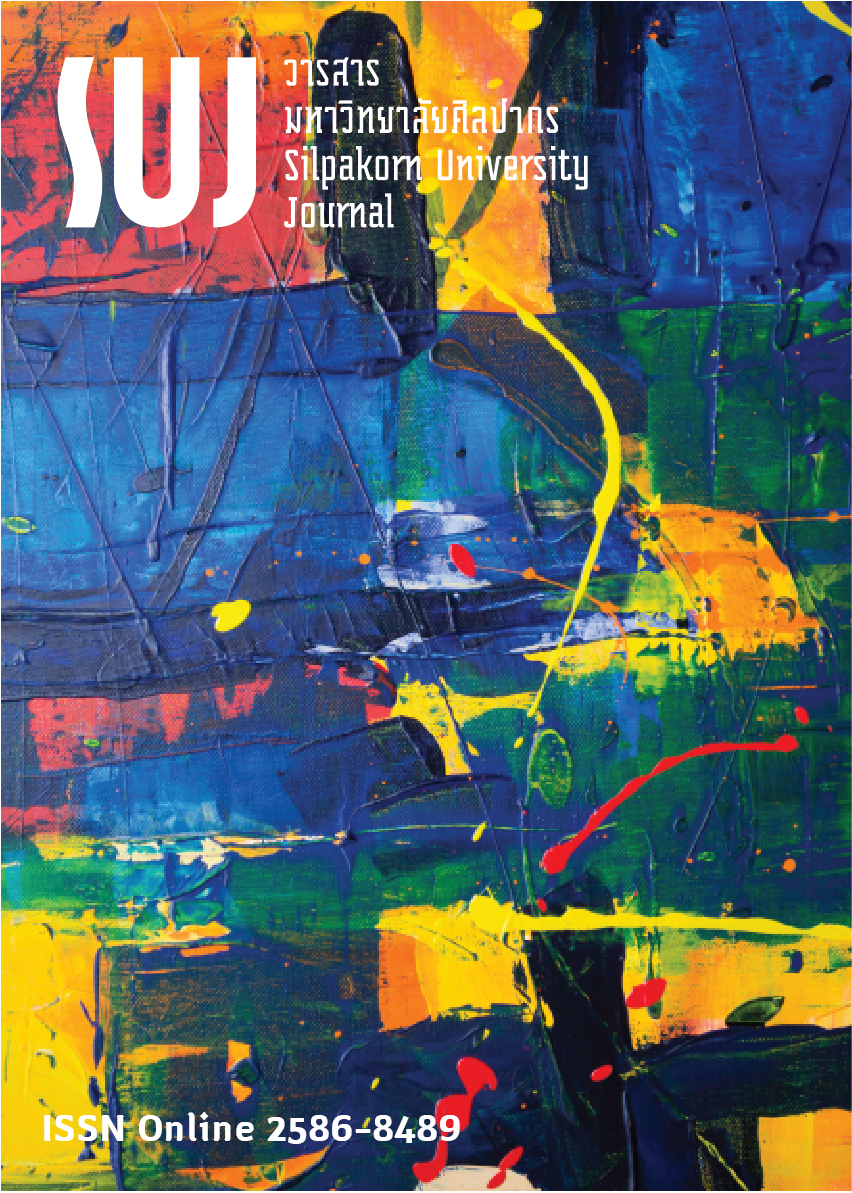แนวทางการควบคุมการขยายตัวของเมืองอย่างไร้ทิศทาง (urban sprawl) กรณีศึกษา : เทศบาลเมืองบัวใหญ่ จังหวัดนครราชสีมา (Guideline for urban sprawl controlling case study of Bua Yai municipality, Nakhon Ratchasima province)
Main Article Content
Abstract
การวิจัยครั้งนี้มีวัตถุประสงค์เพื่อศึกษาการขยายตัวของเทศบาลเมืองบัวใหญ่ จังหวัดนครราชสีมา เพื่อหาแนวทางการใช้ประโยชน์ที่ดินให้เกิดประสิทธิภาพ และควบคุมไม่ให้เมืองขยายตัวอย่างไร้ทิศทาง เนื่องจากเมืองมีโครงการพัฒนาโครงสร้างพื้นฐานของรัฐ และมีบทบาทในการพัฒนาการคมนาคมขนส่งทางราง การที่เมืองเจริญเติบโตและขยายตัวในด้านเศรษฐกิจและสังคม และการเปลี่ยนแปลงการใช้ประโยชน์ที่ดิน กิจกรรมเหล่านี้ล้วนสร้างรายได้ให้กับเมือง แต่ในทางกลับกัน กิจกรรมเหล่านี้ทำให้เมืองสูญเสียพื้นที่สีเขียว ซึ่งเป็นพื้นที่ที่แสดงถึงคุณภาพชีวิตที่ดีของคนในเมือง งานวิจัยนี้ใช้วิธีการวิจัยเชิงเอกสาร ซึ่งผลการวิจัยพบว่า เมืองมีจำนวนประชากรลดลง โดยประชากรส่วนใหญ่มีรายได้จากอาชีพเกษตรกรรม และเศรษฐกิจเจริญเติบโตแบบค่อยเป็นค่อยไป ซึ่งประเด็นสำคัญ คือ อาคารในเมืองมีการขยายตัวเพิ่มขึ้นและส่วนใหญ่ถูกสร้างขึ้นตามแนวถนนทางหลวงแผ่นดินหมายเลข 202 ซึ่งเป็นถนนสายหลักของเมือง ผังเมืองเมืองบัวใหญ่อนุญาตให้จัดสรรที่ดินเพื่อการสาธารณูปโภค สาธารณูปการ และการประกอบกิจการโรงงานบนที่ดินประเภทชนบทและเกษตรกรรม ซึ่งเป็นสาเหตุหลักที่ทำลายพื้นที่สีเขียวของเมือง และส่งผลให้เมืองเกิดการขยายตัวอย่างไร้ทิศทาง ผู้วิจัยจึงมีข้อเสนอแนะในการบริหารจัดการเมือง เพื่อควบคุมทิศทางการขยายตัวของเมือง ดังนี้ 1. การประยุกต์แนวทางการพัฒนาพื้นที่ TOD จากกรณีศึกษาของเมืองอูเมกิตะ (Umekita) ประเทศญี่ปุ่น เพื่อพัฒนาพื้นที่รอบสถานีรถไฟชุมทางบัวใหญ่ให้เป็นศูนย์เศรษฐกิจในละแวกบ้านหรือระดับย่าน (TOD Neighborhood Center) และ 2. การประยุกต์นโยบายการจัดการที่จอดรถและการควบคุมการเดินเท้าในเขตเมือง จากกรณีศึกษาเมืองกูรีตีบา (Coritiba) ประเทศบราซิล เพื่อส่งเสริมการเดินเท้าและแก้ปัญหาการจราจรติดขัด
The research aims to study the expansion of Bua Yai municipality in Nakhon Ratchasima province in order to find the most efficient ways to manage the town and urban expansion. Because Bua Yai municipality had projects to develop governmental infrastructure and has an important role in developing urban rail transit, Bua Yai municipality became more economically and socially developed. Moreover, the usage of the town’s land has been developed by the municipality. As a result, people in the municipallity earn more incomes. On the contrary, green spaces which represent the quality of people’s lives in the town has been decreasing. This study which is a literature review concerning the expansion of Bua Yai municipality found three significant issues. Firstly, the population in the city has decreased. Secondly, most of the population earns money from agriculture and the economy of the town has gradually expanded. Thirdly, the number of the properties which were built along the highway number 202, the main road of the town, has significantly risen. In terms of town planning, Bua Yai municipality divided the town into sections to be served by public utility, public facilities. Additionally, the municipality allowed the establishment of factories in agricultural rural areas. These are the main causes of the deterioration of green areas in the town. Moreover, these policies also resulted in directionless growth of Bua Yai municipality. Based upon the findings, this study offers the municipality two suggestions concerning the municipality’s town planning. First, the Transit Oriented Development (TOD) stated in the case study of Umea Akita in Japan to develop and upgrade the area around the Bua Yai train station may be applied. This is to make the municipality an economic center. Second, to encourage people to travel on foot and to reduce traffic congestion, the municipality may apply the policies to manage car parks and pavements as stated in the case study of Coritiba in Brazil.
Downloads
Article Details

This work is licensed under a Creative Commons Attribution-NonCommercial-NoDerivatives 4.0 International License.
References
Bunyapravitra, Thapana. (2010). Smart Growth Ideas Wisely to stop Bangkok’s Fragmented Growth (การใช้แนวคิดการเติบโตอย่างชาญฉลาด (Smart Growth) เพื่อหยุดยั้งการเติบโตแบบกระจัดกระจายของกรุงเทพมหานคร). [Online]. Retrieved January 6, 2020 from https://asiamuseum.co.th/upload/forum/smart_growth.pdf
Bunyapravitra, Thapana. Where Public Transit Goes… Community Grows (การพัฒนาพื้นที่รอบสถานีขนส่งมวลชนต้องตอบโจทย์การพัฒนาเมืองและเศรษฐกิจ). [Online]. Retrieved January 6, 2020 from http://tatp.or.th/tod-develop-city-economic/
Bua Yai Comprehensive Plan Nakhon Ratchasima 2016 (กฎกระทรวงให้ใช้บังคับผังเมืองรวมเมืองบัวใหญ่ จังหวัดนครราชสีมา พ.ศ. 2559). (2016, 7 April). Ratchakitcha. 133.
Bua Yai District Community Development Office. (2016). History & Data Basic Minimum (ประวัติความเป็นมา & ข้อมูลความจำเป็นพื้นฐานระดับอำเภอ). [Online]. Retrieved April 6, 2020 from https://district.cdd.go.th/buayai/about-us
Bua Yai Municipality & Institute of Nakhon Ratchasima Urban Development. (2016). Bua Yai Comprehensive plan (ผังเมืองรวมเมืองบัวใหญ่ ปรับปรุงครั้งที่ 2). Nakhon Ratchasima: Bua Yai Municipality.
Bunpen, Wanpen. (2017). Curitiba Brazil: The Most Innovation City on a Low Budget. [Online]. Retrieved September 19, 2020 from http://www.tcdc.or.th/articles/design-creativity/27132/#Curitiba-Brazil-The-Most-Innovative-City-on-a-Low-Budget
Bunyapravitra, Thapana, & Panthasen, Tanapon. (2010). Improvement of Bangkok Comprehensive Plan 2006 to Control Urban Sprawl (การปรับปรุงผังเมืองรวมกรุงเทพมหานคร พ.ศ. 2549 เพื่อหยุดยั้งการกระจัดกระจายของเมือง). In Proceedings of 48th Kasetsart University Annual Conference, (pp.154-161). Bangkok: Kasetsart University.
Calthorpe, P. (1993). The Next American Metropolis: Ecology, Community, and the American Dream. [Online]. Retrieved September 19, 2020 from https://www.buildinggreen.com/newsbrief/next-american-metropolis-ecology-community-and-american-dream
Frumkin, H. (2002). Urban Sprawl and Public Health. Public Health Report, 117: 201-217.
Kuanard, Wannobol, & Thinphanga, Pakamas. (2013). Urbanization in Thailand (กระบวนการกลายเป็นเมืองในประเทศไทย). Nonthaburi: Thailand Environment Institute.
Kokpol, Orathai. (2016). Urbanization: When “city” Becomes a Problem of Local Management Modern (เมื่อ“เมือง”กลายเป็นโจทย์ของการบริหารจัดการท้องถิ่นสมัยใหม่). Bangkok: King Prajadhipok’s Institute.
Northem, R. M. (1979). Urban Geography. (2nd ed.). New York: Chichester John Wiley.
Office of Transport & Traffic Policy and Planning. (2018). High-speed Rail Project Bangkok-Nong Khai Phase 2 Nakhon Ratchasima - Nong Khai (โครงการศึกษาและออกแบบรถไฟความเร็วสูงสายกรุงเทพฯ-หนองคาย ระยะที่ 2 ช่วงนครราชสีมา-หนองคาย). [Online]. Retrieved May 6, 2020 from http://www.otp.go.th/index.php/post/view?id=2378
Ongprasert, Saratchat. (2018). Transit Oriented Development (แนวทางการพัฒนาพื้นที่โดยรอบสถานีรถไฟในประเทศไทย). [Online]. Retrieved January 6, 2020 from https://www.matichon.co.th/columnists/news_826240
Poonyakanok, Woraporn. (2016). Transit-Oriented Development (การพัฒนาพื้นที่รอบสถานีขนส่งมวลชน). [Online]. Retrieved September 19, 2020 from http://www.urbanwhy.com/2016/12/20/transit-oriented-development/
Rafferty, J. P. (2015). The Problem of Urban Sprawl. In Saving Earth Encyclopaedia Britannica. [Online]. Retrieved May 20, 2020 from https://www.britannica.com/explore/savingearth/urban-sprawl
Renaissance Planning Group. (2011). A Framework for Transit Oriented Development in Florida. Tallahassee, Florida: The Florida Department of Transportation.


